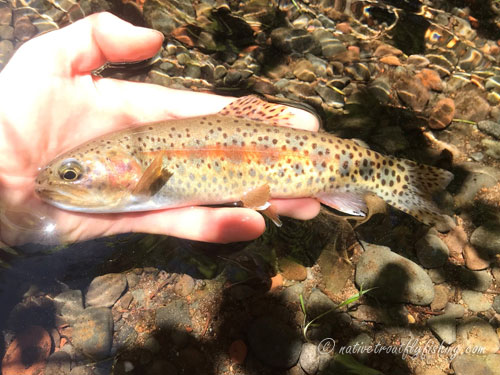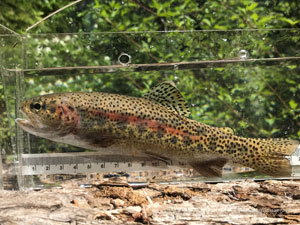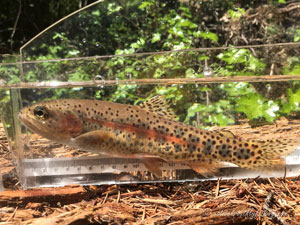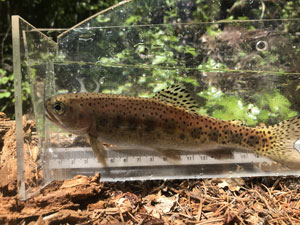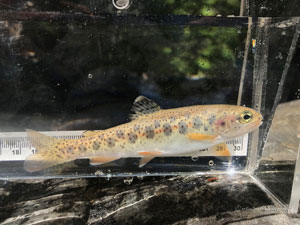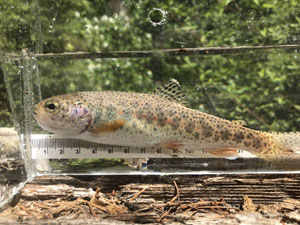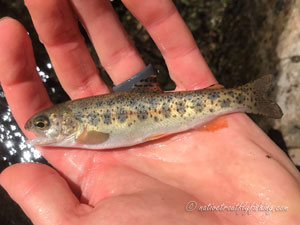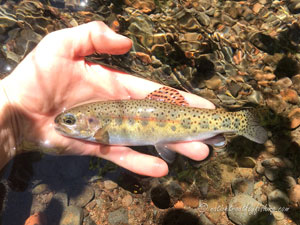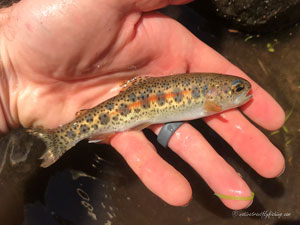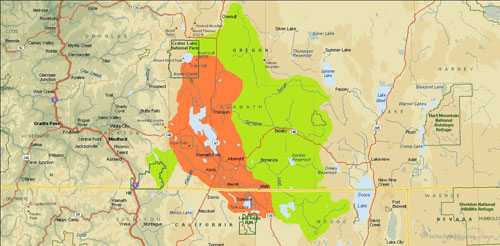Upper Klamath Lakes Redband
Oncorhynchus mykiss newberrii
A stream resident Upper Klamath Redband from a Klamath Lake tribuary stream in southern Oregon.
Introduction
The Klamath Basin of Oregon and California has an odd assemblage of native fish, with the lower portion of the river having species common to other coastal watersheds and the upper portion having species common to Oregon's interior basins. The Klamath Lake Redband Trout were named as the species Salmo newberrii in 1858 (Girard 1856, Girard 1858) for specimens from Upper Klamath Lake and are the only variety of Great Basin Redbands to be formally described. While all Redbands in the Klamath Basin upstream of Klamath Lake are currently classified as Oncorhynchus mykiss newberrii, there is evidence that there are in fact two subspecies of Redband in the Basin. Behnke (1992) indicated that taxonomically the Redbands associated with the Upper Klamath Lakes and those found in the headwaters of the basin were distinct but attributed the steelhead in the lower river to Coastal Rainbow Trout. Genetics work on the Redbands of the Klamath Basin indicate that there are two distinct groupings of Redband Trout in the basin with subspecies level differentiation between them (Currens et al. 2009, Pearse et al. 2011). The first group are the Redbands associated in the Klamath Lake and its tributaries. The second group is associated with the headwaters of the Klamath Basin, including the Upper Williamson River, the Sprague River upstream of Trout Creek and Jenny Creek (Currens et al. 2009). Coastal Rainbow Trout in the lower Klamath River appear to be genetically more similar to Klamath Redbands than to Coastal Rainbow Trout in the lower Columbia River, suggesting genetic exchange between the Coastal and Redband populations of Oncorhynchus mykiss in the basin (Currens et al. 2009). Pearse et al. 2011 indicated that there is not a clear dividing line between coastal lineage (steelhead) and Redband populations, but that they coastal lineage appears to be dominant below Link Dam.
Life History Information
The Upper Klamath Basin was once filled with ancient Lake Modoc, which drained when its outlet cut a channel to the Pacific Ocean via the Klamath River. Today Upper Klamath Lake and Agency Lakes are all that remain of Lake Modoc. Unlike the other interior Redband populations, the Upper Klamath Lake Redband have been able to maintain regular use of the lacustrine environment since the last glacial epoch. As such it maintains the largest and most functional adfluvial Redband population of any of the interior basins (ODFW 2005). The Redbands of the basin exhibit three distinct life history types, adfluvial, fluvial and stream resident, although little is currently known about fluvial and stream resident populations. In addition to these life histories, it is possible that Redband Trout may have exhibited an anadromous life history prior to the construction of dams in the basin (Behnke 1992).
Adfluvial Redband Trout in the Upper Klamath Lakes spawn in tributaries to Klamath and Agency Lakes, such as the lower Sprague, Williamson, and Wood Rivers. Juveniles typically spend one to two years rearing in tributaries to the lakes, prior to migrating downstream when they are between 3” to 7” (8 and 18 cm) to the lakes to rear until maturity (ODFW 2016). Both lakes are highly alkaline, shallow, and naturally eutrophic and the Upper Klamath Lakes Redbands have adapted to survive in these conditions, which would be lethal to most trout. Due to the nature of these two lakes, they are extremely fertile and support abundant zooplankton, aquatic invertebrate, and forage fish populations, resulting in rapid growth for the Redband Trout. While in the lakes the diet of the Redband Trout consists of minnows, sculpin, leeches, midges, water boatmen and other aquatic insects (Tinniswood et al. 2010). Redband Trout in the lakes average 1 to 3 lbs (0.5 to 1.4 kg) (Behnke 2002), but can get much larger, and the largest Redband from the Klamath Lake fishery was 34” (86 cm) long and weighed 25lbs (11.3 kg) (Tinniswood et al. 2010). Even larger Redbands have been recovered on the spawning grounds, with one measuring 37” (94 cm) and weighing 30lbs (13.6 kg) (Messmer and Smith 2007). During summer when conditions in the lakes deteriorate, Redband Trout move into thermal refuge areas, including Pelican Bay as well as tributaries of the lakes. Starting in late winter and continuing through spring these fish migrate up the Wood and Williamson Rivers to reach their spawning grounds (Behnke 2002). Most Redband Trout spawn for the first time at age-3 and often spawn each consecutive year, with fish being documented up to age-8 (Messmer and Smith 2007). Spawning has been observed in the Williamson River occurring between October and July, and there appear to be two distinct spawning runs (ODFW 2016).
Upper Klamath Lakes Redbands exhibiting a fluvial life history strategy poorly understood but are found in a number of streams in the basin. These fish migrate to the lower portions of the basin's rivers to feed, than migrate into tributaries to spawn. Redband Trout downstream of the lakes in the Keno reach of the Klamath River, migrate downstream between March and May to spawn in Spencer Creek (Starcevich et al. 2006). Juveniles from this population migrate upstream and rear in the Keno reach of the river until maturity. Many of the streams in the basin are quite fertile and allow these fish to reach large sizes. Stream resident populations are found in the upper reaches of some of the tributaries to the lakes might only travel only a mile or so during their entire lifespan. Due to their smaller living space these fish generally reach a maximum size of around eight inches on a diet composed mainly of aquatic and terrestrial insects.
Status
Although not listed under the Endangered Species Act, Redband Trout of the Upper Klamath Lakes have been petitioned to be listed and while that listing was denied, they are considered to be at risk of extinction by the Oregon Department of Fish and Wildlife (USFWS 1997, ODFW 2005, Rhew 2007). A variety of issues have affected the abundance and distribution of these fish, with the major issues being habitat destruction, construction of dams and the introduction of non-native fish. Hatchery Rainbow Trout were first stocked into Klamath Lake and its tributaries in the 1920s, with over 12 million Rainbow Trout being planted between 1928 and 1963 (Messmer and Smith 2007). Evidence indicates that interbreeding with hatchery Rainbow Trout has been an issue in some streams in the basin, and hybridization is apparent in several populations (ODFW 2005). However, the Upper Klamath Lakes Redband genotype remains largely intact, especially in populations directly associated with Upper Klamath and Agency Lakes where several factors favor the native trout over introduced Rainbow Trout. Studies in the 1970’s indicated that despite planting 310,000 Rainbow Trout annually, the fish only accounted for 0.4% of the catch in the fishery on the lakes (Messmer and Smith 2007). As a result of this, all hatchery plants in the lake were discontinued in 1979 and plants in most tributaries to the Lakes ceased in 1991 (ODFW 2005), although Spring Creek a primary spawning tributary for adfluvial Redbands was stocked until 2010 (ODFW 2016). The reason for this poor survival is that Upper Klamath Lake is a naturally eutrophic body of water and becomes highly alkaline due to algae blooms making it difficult for hatchery fish to survive. Beyond this a salmonid parasite Ceratomyxa shasta is found throughout the basin and native Redbands are resistant to it, but it is highly lethal to hatchery Rainbow Trout (Behnke 1992, Bartholomew 1998). Beyond hatchery Rainbow Trout, Brook trout and Brown Trout have also been stocked in a number of streams in the Upper Klamath Basin and are known compete with and prey upon the native Redbands.
Beyond non-native trout, other issues facing the Upper Klamath Lake Redband Trout include habitat destruction and barriers to migration. The area around Klamath Lake has been highly altered for agricultural purposes and this as well as logging has resulted in the degradation of stream habitat due to channelization, sedimentation, and water diversions (ODFW 2005). Additionally, much of the wetlands adjacent to Upper Klamath Lake have been drained for agricultural purposes, resulting in both a loss of habitat and increase in the nutrient load added to the lake (Snyder and Morace 1997). While Upper Klamath Lake has likely been eutrophic since before the arrival of Euro-Americans it is now considered to be hyper-eutrophic. This causes large algae blooms followed by a depletion of oxygen, limiting the fish to areas near creek and river mouths or spring fed areas of the lake, such as Pelican Bay. As a result, number of late-summer fish kills have been documented and although they primarily impact other species found in the lakes, some adult Redband have also been killed and it is suspected that these events have a negative impact on the fitness of trout in the lakes (Messmer and Smith 2007). The impacts of dams on migratory fish have caused major declines in the number fluvial of Upper Klamath Lakes Redband Trout. Since the completion of the J.C. Boyle Dam in 1959 migratory redband numbers have declined dramatically from 5,529 in 1959 to just 70 passing over the dam in 1991 (Starcevich et al. 2006). Additionally, if an anadromous life history of Redband Trout originating for the upper Klamath Basin occurred, these fish have been barred access to the ocean for generations.
Description
These fish have an olive or even bluish coloration on the back that transitions to a yellowish color across the body. The coloration migratory individuals may be quite silvery and rather similar in appearance to Coastal Steelhead. Upper Klamath Lakes Redbands typically have a wide pink to brick red band along their lateral line, and their gill plates are a rosy or brick red color. The spotting pattern consists of small round or irregular shaped spots that are distributed primarily above the lateral line and on the caudal and dorsal fins. Fluvial and stream resident populations often have more profuse spotting than adfluvial fish. Purplish colored elliptical shaped parr marks are often retained into maturity on stream resident fish but fade on migratory fish. The dorsal fin may be tipped with either orange or white and the lower fins are tipped with white.
Stream Resident Form
Click on images to view a larger picture
Native Range
A map of the native range of the Klamath basin Redband Trout. Upper Klamath Lakes Redband Trout range in orange and Klamath Headwaters Redband Range in green. Data Sources: Behnke (2002) and ODFW (2005), Pearse et al. (2011).
References
Bartholomew, J.L. 1998. Host resistance to infection by the myxosporean parasite Ceratomyxa shasta: A review. Journal of Aquatic Animal Health 10: 112-120.
Behnke, R.J. 1992. Native trout of western North America. American Fisheries Society Monograph 6. American Fisheries Society, Bethesda, Maryland.
Behnke, R. 2002. Trout and Salmon of North America. Chanticleer Press, New York.
Currens, K.P., C.B. Schreck and H.W. Li. 2009. Evolutionary ecology of redband trout. Transactions of the American Fisheries Society 138: 797–817.ODFW. 2005. Oregon native fish status report. Oregon Dept. of Fish and Wildlife, Salem, OR.
Girard, C. 1856. Notice upon the species of the genus Salmo of authors observed chiefly in Oregon and California. Proceedings of the Philadelphia Academy of Natural Sciences 8: 217–220.
Girard, C. 1858. Ichthyological Notices. Proceedings of the Academy of Natural Sciences of Philadelphia 10: 223-225.
Messmer, R.T. and R.C. Smith. 2007. Adaptive Management for Klamath Lake Redband Trout. Pages 92-98 in R. K. Schroeder and J.D. Hall, editors. Redband trout: resilience and challenge in a changing landscape. Oregon Chapter, American Fisheries Society, Corvallis.
ODFW. 2005. Oregon native fish status report. Oregon Department of Fish and Wildlife, Salem, OR.
ODFW. 2016. Klamath watershed district stock status review of native fish. Oregon Department of Fish and Wildlife, Klamath Falls, Oregon.
Pearse, D.E., S.L. Gunckel and S.E. Jacobs. 2011. Population structure and genetic divergence of coastal rainbow and redband trout in the upper Klamath Basin. Transactions of the American Fisheries Society 140: 587–597.
Rhew, R. 2007. Redband trout and the Endangered Species Act. Pages 123-126 in R. K. Schroeder and J.D. Hall, editors. Redband trout: resilience and challenge in a changing landscape. Oregon Chapter, American Fisheries Society, Corvallis.
Snyder, D.T. and Morace, J.L. 1997. Nitrogen and phosphorus loading from drained wetlands adjacent to Upper Klamath and Agency Lakes, Oregon. U.S. Geological Survey, Water-Resource Investigations Report, Portland, Oregon.
Starcevich, S.J., Jacobs, S.E. and Tinniswood, W. 2006. Effects of dams on redband trout life history in the Upper Klamath River: A summary and synthesis of past and recent studies. Oregon Department of Fish and Wildlife, Information Report, Corvallis.
Tinniswood, W.R., M. Buckman and A.C. Muldoon. 2010. Statistical creel survey on Upper Klamath and Agency Lakes in 2009 and 2010. Oregon Department of Fish and Wildlife. Salem, Oregon.
U.S. Fish and Wildlife Service (USFWS). 1997. A petition for rules to list great basin redband trout (Oncorhynchus mykiss ssp) as threatened or endangered under the Endangered Species Act. Oregon Natural Desert Association, Portland, OR.
Contact
Feel free to contact me if you have any questions or comments
Upper Klamath Lakes Redband Trout Links
My Upper Klamath Lakes Redband Trips
Oregon Department of Fish and Wildlife - Redband Trout
Fremont-Winema National Forest
Upper Klamath National Wildlife Refuge
Harriman Springs Marina - Boat Rentals
Western Native Trout Initiative - Interior Redband Trout
Native Trout Links
Truchas Mexicanas' - Native Trout of Mexico
Balkan Trout Restoration Group
Trout and Seasons of the Mountain Village - About Japanese Trout
Western Native Trout Challenge
California Heritage Trout Challenge
Fly Fishing Blogs
Dave B's Blog: Fly Fishing for Native Trout
The Search for Native Salmonids
Conservation Links
Western Native Trout Initiative
Fly Fishing Links
Fishing Art Links
Americanfishes.com - Joseph R. Tomelleri
